
It’s time to buy a new car.
This is as an exciting thing, especially as you start trying to figure out what exactly you want from your vehicle. If you’re being environmentally conscious, or perhaps just trying to find the car that gives you the very best gas mileage, there is no better (or other) option than a hybrid or electric model.
Hybrid Vehicles vs Electric Vehicles
Before we jump into our list of popular choices on the market today, we’ll briefly discuss the difference between a hybrid car and an all electric car.
A hybrid car is defined, by auto site edmunds.com, as
“…a vehicle is a hybrid if it utilizes more than one form of on-board energy to achieve propulsion. In practice, that means a hybrid will have a traditional internal-combustion engine and a fuel tank, as well as one or more electric motors and a battery pack.”
There is also a subset of hybrid cars known as plug-in hybrids that allow an owner to plug their car in to charge the batteries in the car instead relying solely on the electricity being generated by the car itself.
When it comes to electric vehicles (EVs for short) there are two different types: The two different types are are battery electric cars that use electricity as their only fuel and Fuel Cell vehicles that use hydrogen refueling stations to refuel their cars. Fuel Cell Vehicles are very rare at the moment and make up a very small segment of EVs, most of these vehicles are used in the commercial sector.
Popular Hybrid Vehicles in 2016
All hybrid cars share certain cons just due to their design and the components that they all share, batteries, cooling systems, internal combustion engine, etc. So the following is a list of cons for all Hybrids so that you don’t feel like you are experiencing deja vu every time you read the “cons” list of a car.
- Hybrids are typically heavier than their gasoline engine counterparts. This is due to the weight of batteries, electric engine, cooling systems, etc. This can result in premature tire wear as well as premature replacement of suspension components.
- Plug-in car infrastructure is still lacking for plug-in hybrid vehicles, and charging time can be lengthy if using a 110 volt outlet
- If you drive mainly on highways you won’t see much of a benefit in mileage
- Battery replacement can be expensive
- Getting certain components serviced can be difficult, electric charging components, batteries, etc
- Tend to be more expensive than a non-hybrid
- Tend to be smaller and lack cargo space due to space being taken up by batteries.
We will be basing popularity on the number of vehicles sold in 2016. Hybrid plug-in vehicles will be included as well.
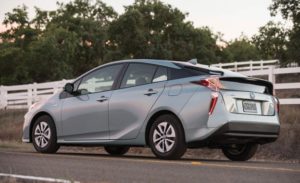
The most popular hybrid vehicle sold in 2016 was the Toyota Prius, with 98,866 sold last year.
Pros
The Toyota Prius has been around the longest and is by far the most proven platform for hybrid cars. They have a proven track record for reliability and developed much of the technology used in cars today.
Cons
The Prius has a large sloping rear window on the hatchback and this causes a rather large blind spot. And, if the look of your vehicle matters, then the Prius may not be for you: It’s got a bug-like exterior with sloping windshield and hard lines.
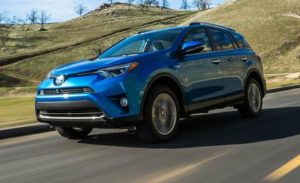
The hybrid that sold second-most was another Toyota: The RAV4 Hybrid sold 45,099 models in 2016.
Pros
The RAV4 has an aggressive stance and a great look for an SUV Hybrid; you would never know it was a hybrid based on looks alone. With a well thought out power train, the RAV4 is not under-powered and does well for a vehicle of its size. The interior is spacious and comfortable.
Con
The exterior has lower trim pieces that are plastic and take away from the look of the car. The interior lacks certain amenities, such as a CD player (if you still play CDs, as I do, you better start downloading music).
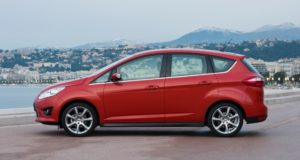
Next on our list of Hybrids was the Ford C-Max which sold 19,834 vehicles in 2016.
Pros
For a smaller vehicle, it has plenty of room for its occupants. The interior features a quiet cabin when driving and features a SYNC3 Infotainment system with touch screen and voice commands. Unlike some hybrids, the C-Max has plenty of power and acceleration, so feel free to jump in the left lane on the freeway. And for all of us that did poorly on parallel parking for our drivers exam, the C-Max has an automatic parallel parking feature (insert the voices of Angels singing here).
Con
If you need a vehicle for camping trips or moving things this is not the vehicle for you: cargo space was sacrificed for cabin room for passengers. The fuel economy is not as impressive as some of its rivals; there are even some gasoline rivals that get better gas mileage.
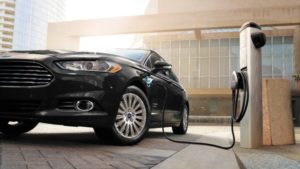
Ford took the fourth spot with its Ford Fusion PHEV (Plug-In Hybrid Electric Vehicle) model selling 15,938 vehicles.
Pros
The car switches seamlessly between EV mode and gasoline mode when set to Auto, and switching back to hybrid mode is equally simple. The car features regenerative breaking to charge your batteries.
Con
The electric mode on this car will only get you 19 miles on a full charge. The battery is located in the trunk, which leaves you with only 8.2 cubic feet to store your gear. The infotainment system, while state-of-the-art, takes time to figure out and is not user-friendly.
Popular Electric Vehicles
Before we jump into the most popular models, there are some general cons to all electric vehicles. I’m going to just start there so I can eliminate some redundancy as you are reading through this.
Cons for all Electric Vehicles
- Driving range of all electric vehicles is very limited in most cases.
- You are often tied to how, where, and when you can charge your vehicle.
- The recharge time for most Electric Vehicles is hours to get any kind of feasible mileage for a trip; if you have issues remembering to charge your phone, Fitbit, or iPod, you may be in store for some surprises.
- The cost of a battery is very, very expensive. It costs about $227 per kWh, and there is no guaranteed life span of a battery.
- Some electric cars lack worthwhile cargo space due batteries taking up space.
- Charging stations outside your home are not wide spread at the moment in most urban settings.
- They are quiet, and you must be ever-vigilant so that someone doesn’t step out in front of you because they didn’t hear your car (I almost got hit by a Tesla in a Target parking lot, these things are like ghosts).
- The Dealership may be the only place to get it fixed. There is certain training necessary to work on EVs due to their high voltage capacitors and other technologies to make them run without gas. General mechanics, at least for the time-being, often don’t have this training.
- As they are just now becoming commonplace, there is still a lack of variety.
The most popular EV for 2016 was the Tesla Model S with 29,156 vehicles sold.
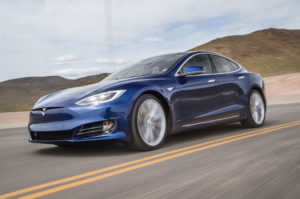
Pros
The biggest pro to any model that Tesla comes out with is the fact that they have figured out how to get the most out of their machines. Unlike most EVs, the Tesla Model S can get up to about 200 miles (give or take a few miles here and there) in city and on the highway before needing to find a charging station, unless you opt for the larger 85 kwh battery which gives you even more. This car looks fantastic and doesn’t fall into the somewhat alien spacecraft look like some hybrids and EVs on the market. Its also fast, like crazy, stupid, fun, fast: It can go 0-60 in under 5 seconds (This is within a half second of certain models of the Chevrolet Corvette or Ford Mustang).
Cons
The biggest con to the Tesla Model S is the price. The cheapest model you can by starts at around $70,000. Due to the size of the batteries in the Tesla Model S charge times can be longer than most, if you are curious you can head on over to HERE where Tesla has a “Home Charging Calculator.” Tesla only has 61 service centers so getting any work done can be painful.
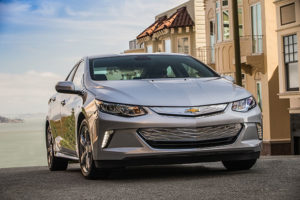
The Chevy Volt sold the second most vehicles in 2016 with 24,739 vehicles sold.
Pros
The Chevy Volt has the appearance of a normal gas operated vehicle. With it’s clean lines and lack of a Hybrid look appearance no one will know it is an EV just by looking at it. Its acceleration at 7.2 seconds is normal for a vehicle its size and not bad at all for an EV. The Volt has regen functions, such as charging the batteries while you use your brakes, that can help optimize how long you can can drive on a single charge.
Con
The back seat would be rather cramped for any one that is an adult. There are a lot of add-on safety features you can get such as lane assist, automatic braking, and forward collision alert but each feature costs $495.
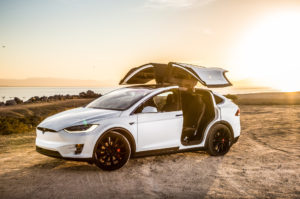
Tesla took the third place in 2016 EV sales by selling 17,500 of its Model X.
Pros
The Tesla Model X is an SUV that has plenty of room for passengers, and can seat up to seven people if the optional third row is purchased. The vehicle has many different trim lines and options including, self-driving technology (Look ma, no hands!), front doors that open on approach, and different drive trains for extended range and acceleration, one allows a zero to 60 speed of just 2.9 seconds.
Con
This vehicle is very expensive for most people. Its base model 75D starts at $82,500, and goes up to $135,500 for the P100D model. As with the Model S, servicing can be an issue as well as finding charge stations in public. Although it is an eye-catching and interesting feature, the gull wing doors that open in the rear take away any ability to use a roof rack and add a level of complexity that could be an issue if the doors become inoperable.
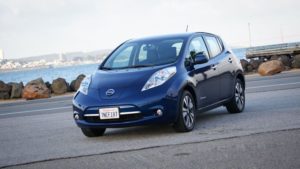
The all electric Nissan Leaf was fourth on the list, selling 14,006 vehicles.
Pros
The Nissan Leaf is as simple in looks as it is mechanically. And, well, it is fairly simple mechanically. It is reliable and typically needs few repairs. The battery is leased from Nissan, so this keeps cost down (about $7,000 off the sticker price), as well as taking away the worry of replacing a battery that may fail.
Con
Although it is great that an owner gets to lease the battery, it adds about $125 a month to owning a Leaf. The Leaf does not have a lot of power and therefore suffers from slow acceleration and a maximum speed of about 65 to 70 mph. It was designed mainly for people that live in cities and not for people that go on long trips.
















